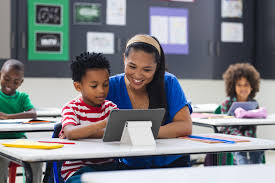In the rapidly evolving world of education, technology and innovative teaching methods are playing a transformative role in shaping the way students learn, educators teach, and institutions function. The traditional classroom setting, once dominated by textbooks and chalkboards, has given way to interactive, dynamic learning environments powered by digital tools, personalized learning techniques, and global connectivity. This revolution is not just about integrating new technology into the classroom—it’s about rethinking the very essence of education, making it more accessible, effective, and aligned with the demands of the 21st century.
In this article, we will explore how technological advancements and modern pedagogical methods are revolutionizing the education landscape, reshaping how learning happens, and the positive impact they are having on students, teachers, and the education system as a whole.
1. The Role of Technology in Modern Education
Technology has become a central force in transforming education, enhancing both teaching and learning experiences. From digital classrooms to virtual learning platforms, technology has introduced several key innovations that have altered the educational landscape.
Digital Classrooms and Learning Management Systems (LMS)
Learning Management Systems (LMS) like Moodle, Google Classroom, and Blackboard have transformed how educators manage and deliver content. These platforms allow teachers to organize assignments, grade students, track progress, and share resources—all in one place. Students, on the other hand, can access materials at their own pace, engage with interactive content, and communicate with peers and instructors beyond the walls of the classroom.
The rise of digital classrooms has also enabled educational institutions to offer more flexibility to students. With the ability to attend classes virtually, students can engage with lessons from anywhere in the world, making education more accessible to people regardless of geographical location. This shift is particularly significant in rural and underserved areas where access to traditional schools might be limited.
Online Learning and MOOCs
Online learning platforms and Massive Open Online Courses (MOOCs) have expanded access to education, breaking down traditional barriers related to location, cost, and time. Platforms like Coursera, edX, Udemy, and Khan Academy offer a wide range of courses, from coding and data science to philosophy and art. These platforms provide learners with the opportunity to acquire new skills and knowledge at their own pace, with many courses being offered for free or at a fraction of the cost of traditional education.
MOOCs have made education accessible to millions of learners globally, democratizing knowledge and enabling lifelong learning. With the growing need for continuous skill development, especially in the age of automation and AI, online learning will continue to play an increasingly important role in education.
Virtual and Augmented Reality (VR/AR)
Virtual reality (VR) and augmented reality (AR) are revolutionizing the classroom by providing immersive learning experiences. These technologies allow students to explore and interact with concepts and environments in ways that were previously unimaginable. For instance, history students can take virtual field trips to ancient civilizations, while biology students can explore the human body in 3D.
VR/AR offers an engaging and hands-on learning experience that enhances student understanding, making abstract concepts more tangible. These technologies also have the potential to revolutionize vocational and technical education, providing students with practical skills in simulated environments before stepping into real-world situations.
2. Personalized Learning: Tailoring Education to Individual Needs
Personalized learning is another transformative trend in education, supported by technology, that focuses on adapting teaching methods and content to the individual needs of each student. Unlike traditional one-size-fits-all approaches, personalized learning seeks to understand the unique strengths, weaknesses, and interests of students, allowing educators to provide targeted instruction that fosters better outcomes.
Adaptive Learning Technologies
Adaptive learning technologies use algorithms to assess a student’s performance and adapt the content and pacing accordingly. These technologies enable students to progress through learning materials at their own pace, ensuring they grasp foundational concepts before moving on to more advanced topics. Programs like DreamBox, Knewton, and Smart Sparrow are already being used in K-12 and higher education settings to tailor learning experiences based on the individual’s abilities and needs.
For example, if a student struggles with a specific concept in math, adaptive learning software can identify this gap and provide additional exercises, explanations, or resources to help the student overcome the challenge. This individualized approach helps students achieve mastery in a subject while building confidence.
Gamification: Making Learning Fun and Engaging
Gamification is the application of game-design elements in non-game contexts, such as education, to make learning more engaging and fun. By introducing rewards, challenges, and levels, educators can motivate students to take an active role in their learning journey. Gamification elements can be integrated into both physical and digital classrooms, transforming otherwise mundane tasks into exciting challenges.
Tools like Kahoot!, Quizlet, and Classcraft allow teachers to incorporate interactive games and competitions into lessons, fostering collaboration and friendly competition. Gamification has proven to boost student engagement, enhance motivation, and promote active learning, especially in subjects that students may traditionally find less exciting.
3. Data-Driven Education: Analytics and Insights for Better Learning Outcomes
One of the most significant benefits of technology in education is the ability to collect and analyze data to improve teaching and learning. Learning analytics, which involves tracking and interpreting data related to student behavior, performance, and engagement, is helping educators make informed decisions about how best to support students.
Learning Analytics: Identifying Patterns and Improving Retention
Learning analytics involves gathering data from various educational platforms, including LMS, digital textbooks, and assessment tools. By analyzing this data, educators can identify patterns in student performance, pinpoint areas where students may be struggling, and intervene before issues become more significant.
For example, if a student’s performance is consistently lower in a particular subject, teachers can provide targeted support such as tutoring, supplemental materials, or specialized interventions to help the student succeed. Additionally, learning analytics helps identify trends, such as the effectiveness of specific teaching methods, allowing educators to fine-tune their approach.
Predictive Analytics: Enhancing Student Success
Predictive analytics uses data to forecast future trends, such as a student’s likelihood of graduating or succeeding in a particular course. By assessing historical data on student behavior, demographic factors, and academic performance, predictive models can identify students who may need additional support, allowing institutions to intervene early and improve retention rates.
Predictive analytics is also helping higher education institutions improve enrollment management, optimize course offerings, and better allocate resources to meet students’ needs. In this way, data is playing a vital role in shaping the future of education.
4. The Rise of Hybrid and Blended Learning
Hybrid and blended learning models combine the benefits of both in-person and online learning, offering a flexible approach to education. In a hybrid model, students alternate between attending physical classes and participating in online activities, whereas blended learning involves the integration of online learning into the traditional classroom setting.
These models provide students with the opportunity to learn at their own pace, engage with multimedia content, and collaborate with peers remotely. Hybrid and blended learning are particularly useful for adult learners, working professionals, and non-traditional students who may struggle with a traditional school schedule. The flexibility of these models is likely to be a major component of the future of education.
5. The Changing Role of Educators
As technology continues to reshape education, the role of the teacher is evolving as well. Educators are no longer the sole source of knowledge in the classroom but are now facilitators, guides, and mentors, helping students navigate a wealth of resources and technologies to explore subjects in greater depth.
The teacher’s role is shifting from being an instructor who imparts information to being a curator of resources, a designer of learning experiences, and a coach who fosters critical thinking, collaboration, and creativity. This transformation requires educators to embrace technology, develop new teaching strategies, and constantly adapt to the changing needs of students.
Conclusion
The revolution of learning through technology and new educational methods is no longer a distant vision—it’s happening right now. From digital classrooms and online learning platforms to AI-driven personalized education and immersive technologies like VR/AR, the tools and approaches available to modern educators and students are reshaping the educational experience.
While these advancements promise exciting possibilities for the future, they also present challenges related to equity, access, and the digital divide. As we continue to innovate and push the boundaries of education, it is essential to ensure that all students have access to the resources and opportunities they need to succeed in this new learning landscape.
Key Takeaways:
- Technology Integration: Tools like Learning Management Systems, virtual learning platforms, and gamification are making learning more engaging, accessible, and flexible.
- Personalized Learning: Adaptive learning technologies and personalized education methods are helping cater to individual student needs and improving learning outcomes.
- Data-Driven Insights: Learning analytics and predictive analytics are helping educators tailor their approach to ensure students succeed.
- Hybrid and Blended Learning: These flexible learning models combine in-person and online education, making learning more adaptable to different student needs and schedules.
- Evolving Role of Educators: Teachers are now facilitators and guides, using technology to help students explore, collaborate, and create in new ways.

